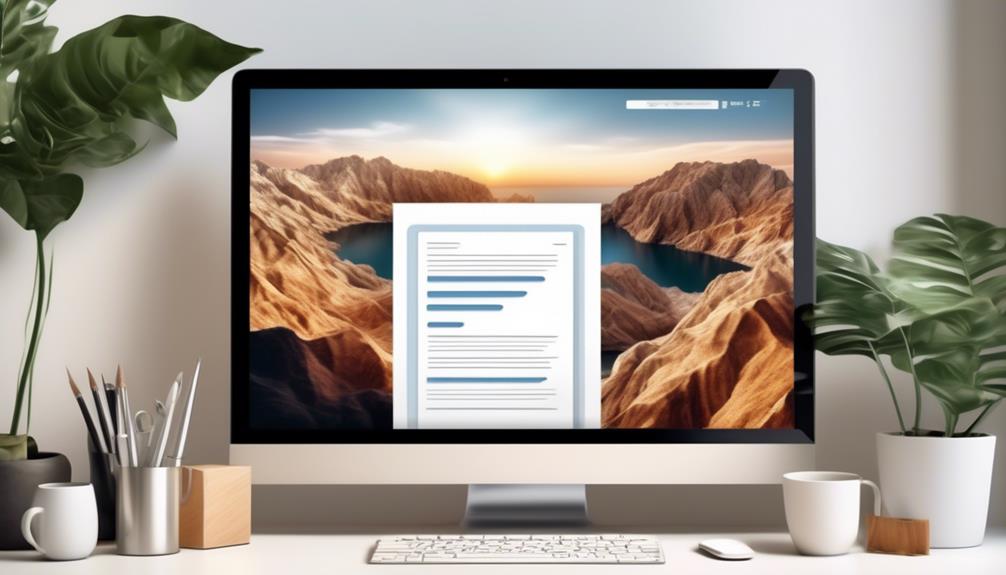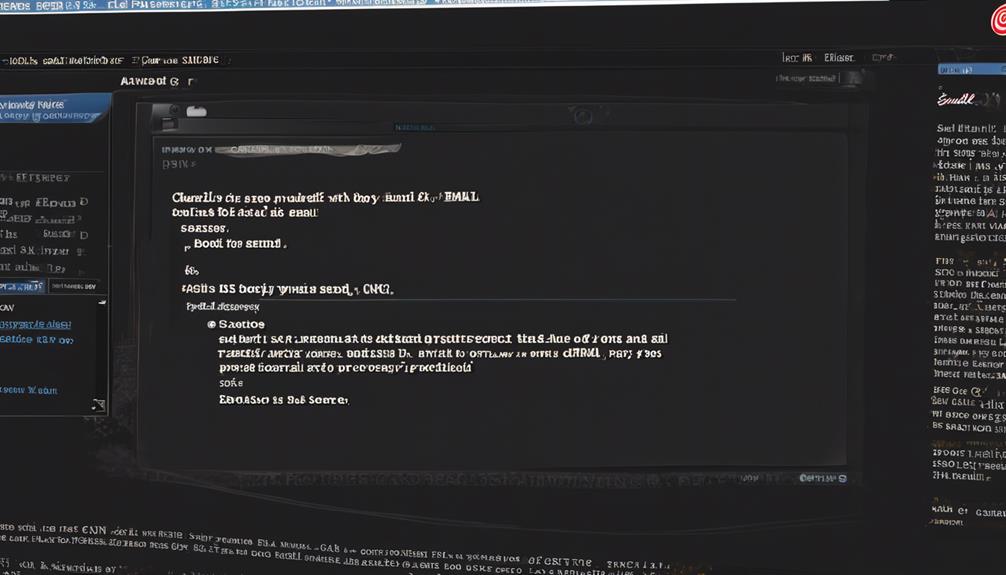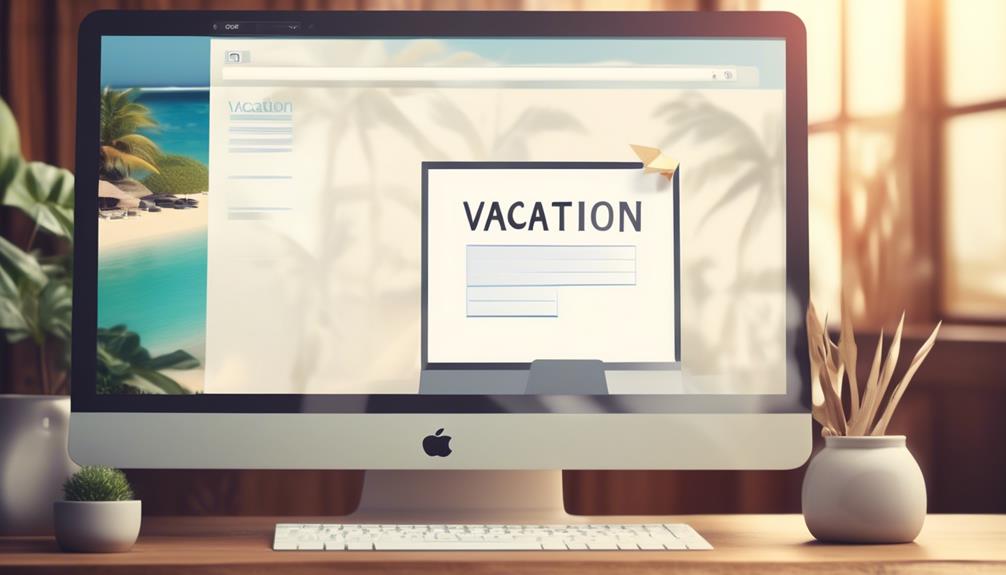It is widely understood that almost 50% of employees don’t fully utilize their vacation benefits, yet have you considered how to compose the perfect vacation email?
It's not just about informing your colleagues of your absence, but also about maintaining professionalism and ensuring a smooth transition during your time off.
The key is to strike the right balance between being polite and straightforward, and in this discussion, we'll explore the essential elements and best practices for composing a vacation email that leaves a positive impression.
Key Takeaways
- Use a clear and concise subject line to indicate the purpose of the vacation email.
- Clearly state the specific dates requested for vacation days.
- Express willingness to address concerns or questions about the absence.
- Maintain a polite and appreciative tone throughout the email, including a thank-you note.
Essential Elements of a Vacation Email
When requesting vacation time, it's essential to clearly communicate the dates and purpose of your time off. In a vacation request email, ensure a smooth and concise subject line that clearly indicates the purpose of your email.
Clearly state the specific dates you're requesting for your vacation days. Additionally, provide a brief explanation for your vacation request, especially during busy periods, if necessary. It's crucial to maintain a professional tone throughout the email.
Express your willingness to address any concerns or questions about your absence. Finally, end the email with a polite and appreciative tone, and include a thank-you note for considering your request.
Crafting a Professional Vacation Email

As we consider the art of crafting a professional vacation email, it's crucial to seamlessly transition from outlining the essential elements of a vacation email to discussing the specifics of maintaining a professional tone and formality in our communication.
When crafting a professional vacation email, it's essential to ensure that the language used aligns with the company's culture and expectations. A good idea is to use a clear and concise subject line that clearly states the purpose of the email, such as 'Formal Vacation Request: [Your Name].'
The body of the email should maintain a professional tone, clearly stating the reason for the vacation request and providing the exact dates of leave. It's important to express willingness to ensure that work responsibilities will be managed during the absence and to address any concerns or questions from the team.
When writing the email, consider using a request email template if available, as this can help maintain a professional structure and formality. Avoid an informal vacation request and instead, ask for the time off in a formal and professional manner, ensuring that the email reflects a professional and respectful tone.
Sample Vacation Request Emails
To effectively request time off for a vacation, consider using a polite and professional email to clearly communicate your planned absence and ensure a smooth approval process. When writing a vacation request email, it's essential to be clear and concise while providing all necessary details. Below is a sample structure for a vacation request email:
| Section | Content |
|---|---|
| Greeting | Dear [Supervisor's Name], |
| Introduction | I am writing to formally request vacation time from [start date] to [end date]. |
| Reason | This vacation is to [briefly mention the reason, if desired]. |
| Work Coverage | I have already spoken with [colleague's name] who has agreed to cover my responsibilities during my absence. |
| Appreciation | Thank you for considering my request, and I look forward to hearing from you soon. |
| Closing | Sincerely, [Your Name] |
When crafting a vacation request email, it's crucial to adhere to company policies, provide ample notice, and express gratitude. By following this sample structure and maintaining a professional tone throughout the email, the chances of a successful vacation request are significantly increased.
Tips for Requesting Vacation Time

We find that providing a detailed overview of our planned absence and arranging for coverage of our responsibilities helps facilitate the vacation request process. When writing a vacation request, it's crucial to be clear and detailed. Start with a polite and concise subject line, such as 'Request for Vacation: [Your Name].' In the email, clearly state the dates of your requested time off, including the start and end dates.
It's also important to provide a brief explanation of why the time off is needed. Whether it's for rest and relaxation, a family event, or another personal reason, briefly explaining the purpose can help in the approval process.
Additionally, it's essential to follow any specific company procedures for requesting time off. Some companies may have a designated form to fill out or a specific protocol to follow. Ensuring that you adhere to these procedures shows respect for company policies.
Lastly, it's wise to arrange coverage for your responsibilities during your absence. Offer a plan for how your work will be managed in your absence, whether it's by delegating tasks to a colleague or providing detailed instructions for your temporary replacement. This demonstrates responsibility and consideration for your team.
Follow-Up and Communication After Sending the Email
Regularly checking for a response, and if necessary, sending a polite follow-up email, can help ensure timely communication and resolution after sending the vacation request email.
After sending a vacation request email, it's essential to follow up and maintain professional communication to ensure that your request is handled promptly and efficiently.
Here are some key steps to follow up and communicate effectively after sending the email:
- Send a Polite Follow-Up Email: If you haven't received a response within a reasonable time frame, consider sending a polite follow-up email to inquire about the status of your vacation request.
- Communicate Approval or Denial: If your request is approved, it's important to communicate the approval to any relevant team members or stakeholders. In the case of a denial, seek feedback to understand the reasons and discuss potential alternatives.
- Keep Lines of Communication Open: It's important to keep the lines of communication open to address any questions or concerns about your absence. This ensures that everyone is aware of your vacation dates and can plan accordingly.
- Express Gratitude and Commitment: Regardless of the outcome, express gratitude for any approval and assure your commitment to completing pending tasks before your vacation. This demonstrates professionalism and responsibility in managing your vacation time.
Frequently Asked Questions
How Do You Write a Simple Vacation Email?
We write a simple vacation email by keeping it brief and professional. We use a polite tone, state the dates of our absence, and explain how we'll handle our responsibilities. We also express willingness to address any concerns.
It's important to be considerate of colleagues' needs. We aim to make the email clear, concise, and respectful. This ensures that our absence is managed effectively and professionally.
How Do You Email Vacation Examples?
We email vacation examples by providing clear and detailed information about our upcoming time off. We can include the dates we'll be away, any relevant contact information for a backup person, and a brief explanation for our absence.
It's important to maintain a professional and courteous tone in the email to ensure a smooth transition while we're away.
How Do You Say Vacation in an Email?
We express the desire to take leave in a professional email by using terms like 'time off,' 'annual leave,' or 'holiday.' It's essential to be clear and polite, stating the exact dates and reason for your absence.
We ensure to express gratitude and offer to address any concerns. This approach maintains professionalism while acknowledging the need for time away.
How Do You Ask for Vacation Days in an Email?
We usually ask for vacation days in an email by clearly stating the dates we're requesting off and providing a brief explanation for the time off.
It's important to be polite and professional in our tone and to follow any specific procedures or protocols outlined by our company.
We should also express gratitude for the consideration of our request and be open to discussing any necessary arrangements.
Conclusion
In conclusion, taking the time to craft a well-written vacation email is essential for ensuring a smooth and respectful process. Remember to dot your i's and cross your t's before hitting send, and keep your colleagues in the loop.
After all, it's better to be safe than sorry, and a little communication goes a long way in maintaining a positive work environment. Happy vacation planning!










